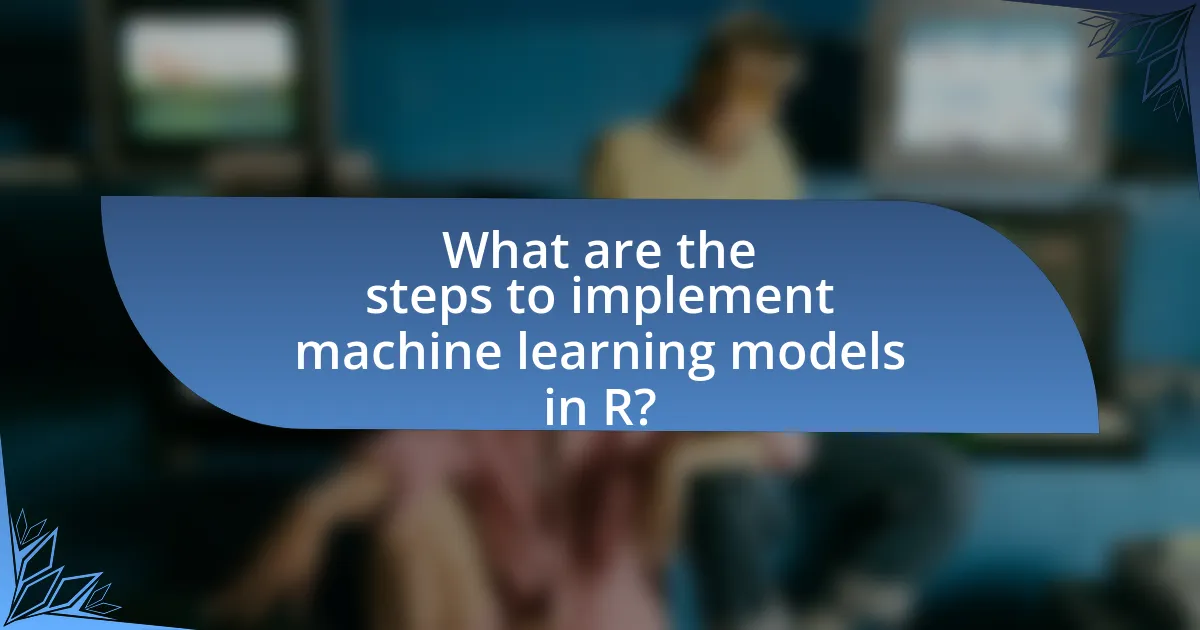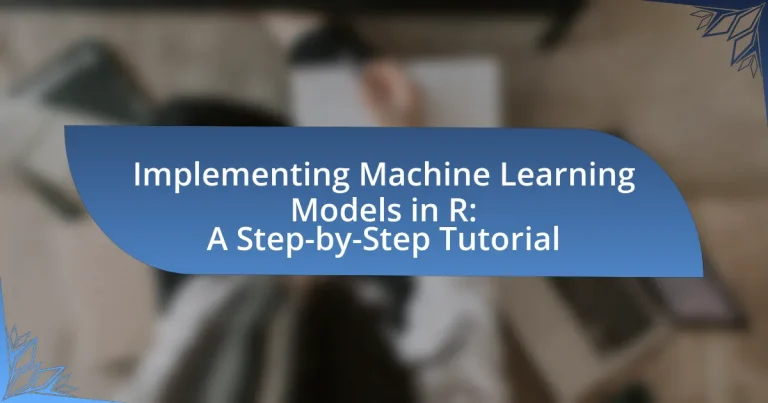Implementing machine learning models in R involves utilizing the R programming language to create, train, and evaluate predictive models using various data types. The article outlines the key components of this process, including data preparation, model selection, training, evaluation, and deployment, while highlighting essential libraries such as caret, randomForest, and xgboost. It also discusses the differences between supervised and unsupervised learning, the importance of data types, and best practices for enhancing model performance. Additionally, the article provides insights into evaluating model accuracy and visualizing results, making it a comprehensive guide for data scientists and practitioners interested in machine learning with R.

What is Implementing Machine Learning Models in R?
Implementing machine learning models in R involves the process of using the R programming language to create, train, and evaluate predictive models based on data. R provides a variety of packages, such as caret, randomForest, and glmnet, which facilitate the implementation of different machine learning algorithms, including regression, classification, and clustering. The effectiveness of R in this domain is supported by its extensive libraries and community contributions, making it a popular choice among data scientists for statistical analysis and machine learning tasks.
How do machine learning models function within R?
Machine learning models function within R by utilizing various packages and functions designed for data manipulation, model training, and evaluation. R provides a rich ecosystem, including libraries such as caret, randomForest, and glmnet, which facilitate the implementation of different algorithms like decision trees, support vector machines, and linear regression. These packages allow users to preprocess data, split datasets into training and testing sets, fit models to the training data, and assess model performance using metrics such as accuracy, precision, and recall. The integration of visualization tools in R also aids in interpreting model results, making it easier to understand the relationships within the data.
What are the key components of machine learning in R?
The key components of machine learning in R include data preparation, model selection, training, evaluation, and deployment. Data preparation involves cleaning and transforming data into a suitable format for analysis, often using packages like dplyr and tidyr. Model selection refers to choosing the appropriate algorithm for the task, such as linear regression, decision trees, or neural networks, facilitated by libraries like caret and mlr. Training is the process of fitting the model to the data, which can be executed using functions from these libraries. Evaluation assesses the model’s performance through metrics like accuracy, precision, and recall, often visualized using ggplot2. Finally, deployment involves integrating the model into a production environment, which can be achieved using tools like plumber for creating APIs. These components are essential for effectively implementing machine learning models in R.
How do data types in R influence machine learning models?
Data types in R significantly influence machine learning models by determining how data is processed and interpreted. For instance, numeric data types are essential for algorithms that require mathematical computations, while categorical data types are crucial for classification tasks, as they allow models to differentiate between distinct groups. The handling of factors in R, which represent categorical variables, directly affects model performance; improper encoding can lead to suboptimal results. Additionally, the choice of data type impacts memory usage and computational efficiency, as certain algorithms may perform better with specific data structures. For example, decision trees can handle categorical variables natively, while linear regression requires numerical input, highlighting the importance of data type selection in model accuracy and efficiency.
What are the advantages of using R for machine learning?
R offers several advantages for machine learning, including a rich ecosystem of packages, strong statistical capabilities, and excellent data visualization tools. The extensive library of packages, such as caret and randomForest, facilitates the implementation of various machine learning algorithms with ease. R’s statistical foundation allows for advanced data analysis and modeling, making it suitable for complex datasets. Additionally, R’s visualization libraries, like ggplot2, enable users to create insightful visual representations of data and model results, enhancing interpretability. These features collectively make R a powerful tool for machine learning applications.
Which features of R make it suitable for machine learning?
R is suitable for machine learning due to its extensive libraries, statistical capabilities, and data visualization tools. The language offers packages like caret, randomForest, and e1071, which provide a wide range of algorithms for classification, regression, and clustering. R’s strong statistical foundation allows for advanced data analysis and model evaluation, making it easier to interpret results. Additionally, R’s visualization libraries, such as ggplot2, enable effective data exploration and presentation, which are crucial for understanding model performance and data patterns. These features collectively enhance R’s utility in developing and deploying machine learning models.
How does R compare to other programming languages for machine learning?
R is highly regarded for machine learning due to its extensive libraries and statistical capabilities, making it particularly strong in data analysis and visualization. Compared to Python, R excels in statistical modeling and has a rich ecosystem of packages like caret and randomForest, which are specifically designed for machine learning tasks. Additionally, R’s syntax is often more intuitive for statisticians, facilitating easier implementation of complex statistical methods. In contrast, Python offers broader applications beyond data science and has a larger community, which results in more resources and support for machine learning frameworks like TensorFlow and PyTorch. However, R’s focus on statistical analysis makes it a preferred choice for academic research and specialized statistical tasks.

What are the steps to implement machine learning models in R?
To implement machine learning models in R, follow these steps: first, install and load necessary libraries such as ‘caret’, ‘randomForest’, or ‘e1071’. Next, prepare your dataset by cleaning and preprocessing the data, which includes handling missing values and normalizing or scaling features. Then, split the dataset into training and testing sets to evaluate model performance accurately. After that, select an appropriate machine learning algorithm based on the problem type, such as classification or regression. Train the model using the training dataset and tune hyperparameters to optimize performance. Finally, evaluate the model using the testing dataset and metrics like accuracy, precision, or RMSE, and visualize results to interpret the model’s effectiveness. These steps are essential for successfully implementing machine learning models in R.
How do you prepare data for machine learning in R?
To prepare data for machine learning in R, you need to follow several key steps: data cleaning, data transformation, and data splitting. Data cleaning involves handling missing values, removing duplicates, and correcting inconsistencies in the dataset. For instance, the na.omit() function can be used to remove rows with missing values, ensuring the dataset is complete. Data transformation includes normalizing or standardizing numerical features, encoding categorical variables using functions like factor() or model.matrix(), and creating new features if necessary. Finally, data splitting is crucial for model evaluation; typically, the dataset is divided into training and testing sets using the sample() function or the caret package, ensuring that the model can be validated on unseen data. These steps are essential for building effective machine learning models in R.
What techniques are used for data cleaning in R?
Techniques used for data cleaning in R include handling missing values, removing duplicates, and correcting data types. Handling missing values can be achieved through functions like na.omit() or using the mice package for imputation. Removing duplicates is often done with the unique() function or the dplyr package’s distinct() function. Correcting data types can involve using as.numeric(), as.character(), or as.factor() to ensure data is in the appropriate format for analysis. These techniques are essential for preparing datasets for machine learning models, ensuring accuracy and reliability in results.
How can you handle missing values in R datasets?
To handle missing values in R datasets, you can use several methods including imputation, removal, or using algorithms that support missing values. Imputation involves replacing missing values with substituted values, such as the mean, median, or mode of the column, which can be done using functions like mean() or median() combined with is.na(). Removal entails deleting rows or columns with missing values using the na.omit() or na.exclude() functions. Additionally, certain machine learning algorithms, such as decision trees, can handle missing values directly without requiring imputation. These methods are widely recognized in data preprocessing and are essential for ensuring the integrity of machine learning models.
What are the different types of machine learning models you can implement in R?
The different types of machine learning models you can implement in R include supervised learning models, unsupervised learning models, and reinforcement learning models. Supervised learning models, such as linear regression, decision trees, and support vector machines, are used for tasks where the output variable is known. Unsupervised learning models, including k-means clustering and hierarchical clustering, are applied when the output variable is not known, focusing on finding patterns in the data. Reinforcement learning models, like Q-learning, are utilized for decision-making tasks where an agent learns to make choices through trial and error. R provides various packages, such as caret, randomForest, and e1071, to facilitate the implementation of these models, demonstrating its versatility in machine learning applications.
What is the difference between supervised and unsupervised learning in R?
Supervised learning in R involves training a model on a labeled dataset, where the output is known, allowing the model to learn the relationship between input features and the target variable. In contrast, unsupervised learning in R deals with unlabeled data, where the model identifies patterns or groupings without prior knowledge of the outcomes. For example, supervised learning techniques like linear regression or decision trees predict outcomes based on input data, while unsupervised methods like k-means clustering or hierarchical clustering group data points based on similarities. This distinction is crucial for selecting the appropriate machine learning approach based on the nature of the dataset and the problem at hand.
How do you choose the right model for your data in R?
To choose the right model for your data in R, first assess the nature of your data, including its type (categorical or continuous), size, and distribution. For instance, if your data is categorical, models like logistic regression or decision trees may be appropriate, while linear regression suits continuous data. Additionally, consider the complexity of the relationships in your data; simpler models may suffice for linear relationships, whereas more complex models like random forests or neural networks are better for non-linear patterns.
Evaluating model performance through techniques such as cross-validation and metrics like accuracy, precision, and recall will further guide your choice. Research indicates that using the right model can significantly enhance predictive performance, as shown in studies comparing various algorithms on benchmark datasets.

What tools and libraries are essential for machine learning in R?
The essential tools and libraries for machine learning in R include caret, randomForest, e1071, and xgboost. Caret provides a unified interface for various machine learning algorithms, facilitating model training and evaluation. RandomForest implements the random forest algorithm for classification and regression tasks, while e1071 offers support vector machines and other utilities. Xgboost is known for its efficient implementation of gradient boosting, which is widely used in competitive machine learning. These libraries are widely adopted in the R community, supported by extensive documentation and user contributions, making them reliable choices for machine learning projects.
Which R packages are most commonly used for machine learning?
The most commonly used R packages for machine learning are caret, randomForest, and xgboost. Caret provides a unified interface for various machine learning algorithms and simplifies the process of model training and evaluation. RandomForest is widely utilized for its effectiveness in classification and regression tasks through ensemble learning. Xgboost is known for its high performance in predictive modeling, particularly in competitions like Kaggle. These packages are frequently referenced in literature and practical applications, demonstrating their significance in the R machine learning ecosystem.
How do you install and load machine learning libraries in R?
To install and load machine learning libraries in R, use the install.packages() function followed by the library() function. For example, to install the ‘caret’ library, execute install.packages(“caret”) in the R console, then load it with library(caret). This method is standard for adding and utilizing packages in R, ensuring access to various machine learning functionalities.
What functionalities do popular R packages like caret and randomForest provide?
The R package caret provides functionalities for streamlining the process of training and evaluating machine learning models, including data preprocessing, feature selection, and model tuning through a unified interface. Additionally, caret supports a wide range of algorithms, allowing users to easily switch between different modeling techniques and assess their performance using cross-validation and resampling methods.
The randomForest package specializes in creating and utilizing random forest models, which are ensemble learning methods that combine multiple decision trees to improve predictive accuracy and control overfitting. This package offers functionalities for both classification and regression tasks, variable importance assessment, and the ability to handle missing data effectively.
Together, these packages enhance the machine learning workflow in R by providing comprehensive tools for model development and evaluation.
How can you evaluate the performance of machine learning models in R?
To evaluate the performance of machine learning models in R, you can use various metrics such as accuracy, precision, recall, F1 score, and area under the ROC curve (AUC). These metrics provide quantitative measures of how well the model predicts outcomes based on a test dataset. For instance, the caret package in R offers functions like confusionMatrix() to compute accuracy and other statistics, while the pROC package can be used to calculate AUC. Additionally, cross-validation techniques, such as k-fold cross-validation, can be implemented using the train() function in the caret package to ensure that the model’s performance is robust and not overfitted to the training data.
What metrics are used to assess model accuracy in R?
Metrics used to assess model accuracy in R include accuracy, precision, recall, F1 score, and area under the ROC curve (AUC). Accuracy measures the proportion of correct predictions among total predictions. Precision indicates the ratio of true positive predictions to the total predicted positives, while recall measures the ratio of true positives to the actual positives. The F1 score combines precision and recall into a single metric, providing a balance between the two. AUC evaluates the model’s ability to distinguish between classes across different threshold settings. These metrics are commonly implemented in R using packages such as caret, pROC, and ROCR, which facilitate the calculation and visualization of model performance.
How do you visualize model performance in R?
To visualize model performance in R, you can use various packages such as ggplot2, caret, and pROC. These packages allow you to create visualizations like ROC curves, confusion matrices, and precision-recall curves. For instance, the pROC package provides functions to plot ROC curves, which illustrate the trade-off between sensitivity and specificity for different thresholds, helping to assess the model’s classification performance. Additionally, the caret package can generate confusion matrices that visually represent the performance of a classification model by showing the counts of true positive, true negative, false positive, and false negative predictions. These visualizations are essential for understanding how well a model performs and for comparing different models effectively.
What are best practices for implementing machine learning models in R?
Best practices for implementing machine learning models in R include data preprocessing, model selection, hyperparameter tuning, and validation techniques. Data preprocessing involves cleaning and transforming data to ensure quality inputs, which is crucial as poor data can lead to inaccurate models. Model selection requires choosing the appropriate algorithm based on the problem type, such as regression or classification, and understanding the strengths and weaknesses of each algorithm. Hyperparameter tuning optimizes model performance by adjusting parameters to improve accuracy, often using techniques like grid search or random search. Validation techniques, such as cross-validation, help assess model performance and prevent overfitting by ensuring that the model generalizes well to unseen data. These practices are supported by numerous studies, including “An Introduction to Statistical Learning” by Gareth James et al., which emphasizes the importance of these steps in achieving robust machine learning outcomes.
How can you avoid common pitfalls when using R for machine learning?
To avoid common pitfalls when using R for machine learning, ensure proper data preprocessing and validation techniques are employed. Data preprocessing includes handling missing values, normalizing or scaling features, and encoding categorical variables, which are crucial for model accuracy. Additionally, implementing cross-validation techniques helps in assessing model performance and preventing overfitting. Research indicates that proper data handling can improve model performance by up to 20% (Kuhn & Johnson, 2013, “Applied Predictive Modeling”). By focusing on these practices, users can significantly reduce errors and enhance the reliability of their machine learning models in R.
What tips can enhance the efficiency of machine learning workflows in R?
To enhance the efficiency of machine learning workflows in R, utilize parallel processing to speed up computations. R packages like ‘parallel’ and ‘foreach’ allow for the execution of multiple tasks simultaneously, significantly reducing processing time. Additionally, employing data.table for data manipulation can improve performance due to its optimized memory usage and speed compared to traditional data frames. Furthermore, using the caret package can streamline model training and tuning by providing a unified interface for various machine learning algorithms, which simplifies the workflow. These strategies are supported by empirical evidence showing that parallel processing can reduce computation time by up to 90% in certain scenarios, while data.table can handle larger datasets more efficiently than base R data frames.


